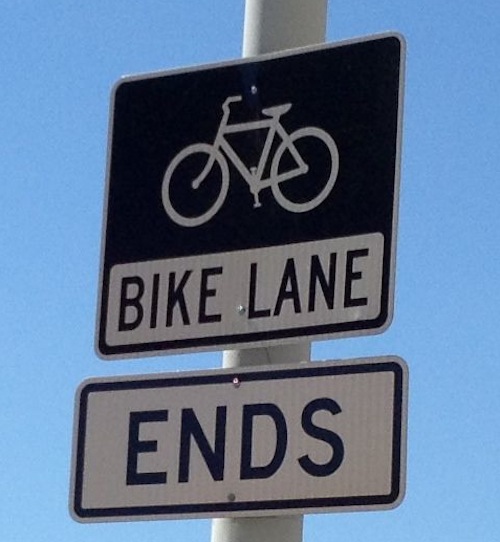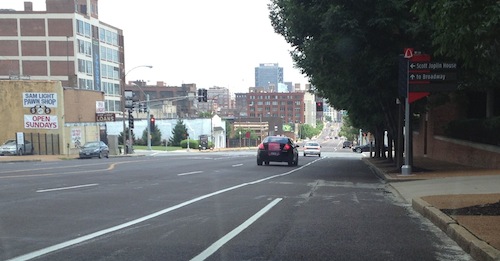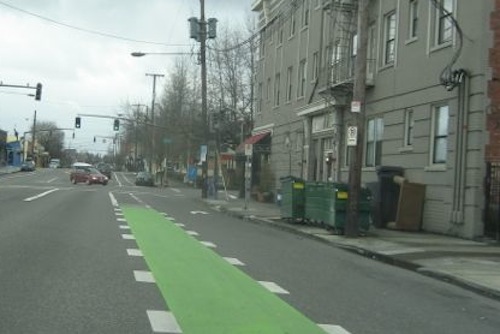Bike Lanes: Do Them Right Or Don’t Bother
Bike lanes, when done right, can greatly assist the users by guiding them and making motorists more aware. Done wrong, the cyclist often ends up in the wrong position at an intersection. Most of the time in St. Louis our bike lanes are flawed, especially at intersections.


In the situations above most people on bikes will incorrectly shift to the right so they’ll be to the right of right turning vehicles — not good for the cyclists or motorists. Bikes are vehicles so those continuing straight through the intersection need to be positioned to do that. Above, that means being on the white line separating the through lane from the right turn lane.
In cities where they do more than lip service bike lanes are more helpful.

In the above example from Portland, even the most amateur cyclist will stay in the proper position on the roadway to continue forward. Motorists will be able to get into the right turn lane and turn without conflicting with the cyclist.
Colored bike lanes have been a feature of bicycle infrastructure in the Netherlands (red), Denmark (blue), France (green) and many other countries for many years. In the United Kingdom, both red and green pigments are used to delineate bike lanes and bike boxes. However, in this country their use has been limited to a few experiments in just a handful of locations. The most extensive trial took place in Portland, Ore., where a number of critical intersections had blue bike lanes marked through them and the results were carefully monitored. The results of the study, conducted by the City of Portland Office of Transportation and the UNC Highway Safety Research Center, can be found here.
The Portland photo was taken about a decade after their study. Portland cyclists must still be skilled to be able to make left turns, for example.
— Steve Patterson
In your Portland picture, the bike lane is more understandable, but the dumpsters on the sidewalk certainly sucks for pedestrians . . .
Yes, but this was the best picture I had to use. Very rare situation based on my experience.
I have to say that I’m generally impressed with the cycling accommodations that both city and county have made in the St Louis area. Before I left home for college not too long ago, all my life I was forced to ride my bike in deep, deep south Alabama on narrow county roads, where the typical vehicle was the widest pick-em-up truck that the law would allow, where there were no designated bike lanes, no sidewalks, and the speed limit was 45 (interpreted as 65). I learned to ride defensively and acutely aware of my surroundings…..and so I find biking here in Missouri to be a pleasure. But I would welcome the use of colored bike lanes here in St Louis. (I too noticed the dumpsters blocking the sidewalk but had already decided not to mention it.)
Portland isn’t perfect? Oh my!
I do like the dedicated, colored bike lanes. I think it would make it easier for both to know that yes, bikes do get part of the road. Now….how do we get bikers to observe the same rules of the road as the drivers?
Make biking as dangerous to others and as wasteful of space we all have to share as driving is, that’s how.
How many miles of colored bike lanes are there in Portland? This is a relatively expensive investment, and while it is justified in Europe, I suspect most US cities have too low density and too many road-miles per person to support it. I mean, we can’t even fix potholes promptly.
P.S. Congratulations on fixing the comment counts on the front page.
They only colour them when needed at intersections and other areas where confusion might be an issue….so cost is arguably a non-issue (maybe?).
The only such instance of this I have seen in the city is on East bound Wydown at Skinker. Looks very much like Steve’s example.